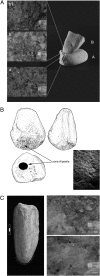Thirty thousand-year-old evidence of plant food processing
- PMID: 20956317
- PMCID: PMC2973873
- DOI: 10.1073/pnas.1006993107
Thirty thousand-year-old evidence of plant food processing
Abstract
European Paleolithic subsistence is assumed to have been largely based on animal protein and fat, whereas evidence for plant consumption is rare. We present evidence of starch grains from various wild plants on the surfaces of grinding tools at the sites of Bilancino II (Italy), Kostenki 16-Uglyanka (Russia), and Pavlov VI (Czech Republic). The samples originate from a variety of geographical and environmental contexts, ranging from northeastern Europe to the central Mediterranean, and dated to the Mid-Upper Paleolithic (Gravettian and Gorodtsovian). The three sites suggest that vegetal food processing, and possibly the production of flour, was a common practice, widespread across Europe from at least ~30,000 y ago. It is likely that high energy content plant foods were available and were used as components of the food economy of these mobile hunter-gatherers.
Conflict of interest statement
The authors declare no conflict of interest.
Figures



References
-
- Hardy BL. Climatic variability and plant food distribution in Pleistocene Europe: Implications for Neanderthal diet and subsistence. Quat Sci Rev. 2010;29:662–679.
-
- Mason SLR, Hatler JG, Hillman GC. Preliminary investigation of plant macro-remains from Dolní Věstonice II, and its implications for the role of plant foods in Paleolithic and Mesolithic Europe. Antiquity. 1994;68:48–57.
-
- Karkanas P, et al. The earliest evidence for clay hearths: Aurignacian features in Klisoura Cave I, southern Greece. Antiquity. 2004;78:513–525.
-
- Lev E, Kislev ME, Bar-Yosef O. Mousterian vegetal food in Kebara Cave, Mt. Carmel. J Archaeol Sci. 2005;32:475–484.
Publication types
MeSH terms
Substances
LinkOut - more resources
Full Text Sources
Molecular Biology Databases

